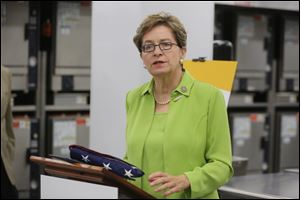
SATURDAY ESSAY
Turn urban blight into agricultural oasis
10/27/2017
TOLEDO IS truly a “City in a Garden,” nestled along the Maumee River as it bends toward Lake Erie, winding through the fertile soils of the former Great Black Swamp.
The Toledo Mud Hens’ symbol, the coot, is a duck known to flourish in this vibrant freshwater ecosystem. Our city’s unique location has enabled many generations to support food and landscape production platforms and products, undercover production in greenhouses, and further out, livestock operations and vast fields of soybean and corn.

Rep. Marcy Kaptur
In fact, Lucas County ranks in the top 5 percent of counties nationally for its valuable greenhouse nursery crop. Growers produce strawberries, soybeans, corn hops, vegetables, and fruits. Throughout Toledo and Lucas County, production greenhouses yield fresh produce serving area households and the horticulture and nursery markets.
Local citizens are building on this priceless heritage and taking up the challenge to “buy local” foods close to home. Inspired by pioneering technologies and the acute need for fresh, affordable produce, cities are rediscovering the power of the earth to nurture and empower themselves. Forgotten corners of urban America are being transformed coast to coast.
As the daughter of parents who operated a family market, I am acutely aware of the intersection between food and those precious assets that encourage vibrant communities and healthy lifestyles. It is why I have championed federal attention to urban farmers’ markets and local food systems, including piloting the popular Senior Farmers Market Coupon program. I have also worked hard to establish a Maumee Valley Growers network, the Robert J. Anderson Urban Agriculture Center, home to Toledo GROWS program in Central Toledo, and the Center for Innovative Food Technologies to help bring new technologies and products to market.
These early seeds continue to bear fruit in the form of local economic growth and healthy foods. With supportive federal policies, and with a new Farm Bill on the horizon, restoring local food systems can achieve transformative results in new production platforms.
Growing food close to home makes economic sense. It cuts transportation costs of fresh fruits and vegetables, most of which we get from the West Coast. And it drives money back in the pockets of local producers and distributors. It is time to remove the artificial border between urban and rural producers. As innovative greenhouse growers already understand, being close to market and close to shelf is a significant price advantage.
Yet, too many urban neighborhoods are in food deserts, absent grocery stores or markets where people can purchase affordable, fresh, and healthy foods. Blighted properties remain underutilized as diamonds in the rough that have the potential to be turned into bustling production centers, tended fields, or markets.
That is why I introduced H.R. 3699, the Urban Agriculture Production Act of 2017. This measure, supported by Democrats and Republicans, further engages the federal government to bridge the rural-urban divide by supporting the development and expansion of food production systems in our most undernourished, underserved, and underinvested cities and towns.
The bill establishes an urban agriculture liaison and outreach program at the U.S. Department of Agriculture, a point person to champion urban agriculture for communities across our nation. It would also expand the Senior Farmers’ Market Nutrition Program to include veterans, and provide competitive grants and loans to advance agriculture in our cities.
These measures will offer communities the access to resources and support the need to invest and reinvest in urban food and landscape production systems and access to healthy, fresh foods.
Throughout our urban communities, there is an abundance of unused land located in neighborhoods that could be ripe for appropriate agriculture production. We must do more to support and encourage the means to develop these plots so they become local sources of wholesome food options.
The Urban Agriculture Production Act encourages just that and furthers the mission of local farming. It inspires communities to build self-sufficient food systems that will stimulate economic development and produce healthy eating options. And by providing better, fresh, and nutritional foods, we can reduce the rate of diabetes, hypertension, and other obesity-related illnesses.
Communities across America are working to address the challenges people face in buying fresh and nutritious foods. As Congress readies to debate and reauthorize a new Farm Bill, our nation has an opportunity to bring “farm to city” and usher in a new era of urban agriculture. Let’s build on the experience of local pioneers such as Toledo GROWS, so we may capture this new energy for America in a restorative effort to provide fresh, affordable, and healthy food, engaging people in all our communities.
Marcy Kaptur (D., Toledo) is the U.S. representative for Ohio’s 9th congressional district.